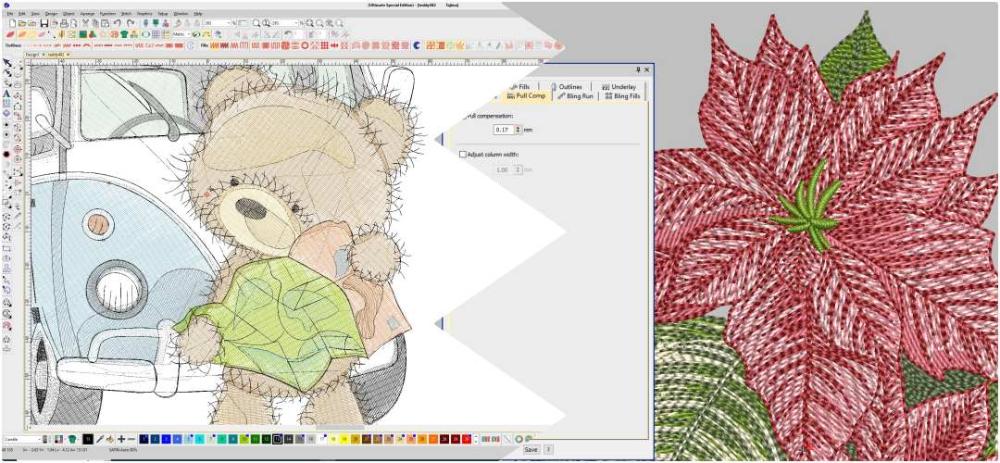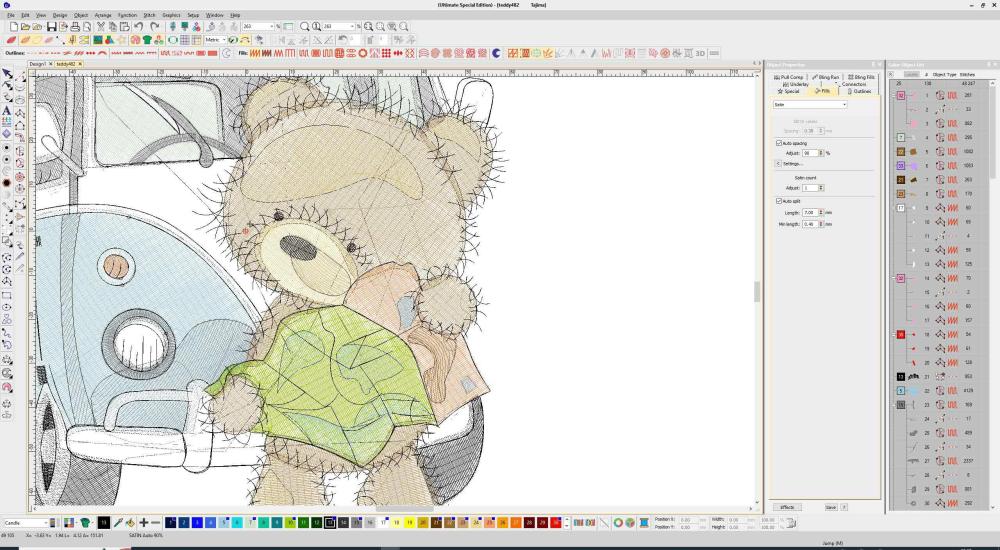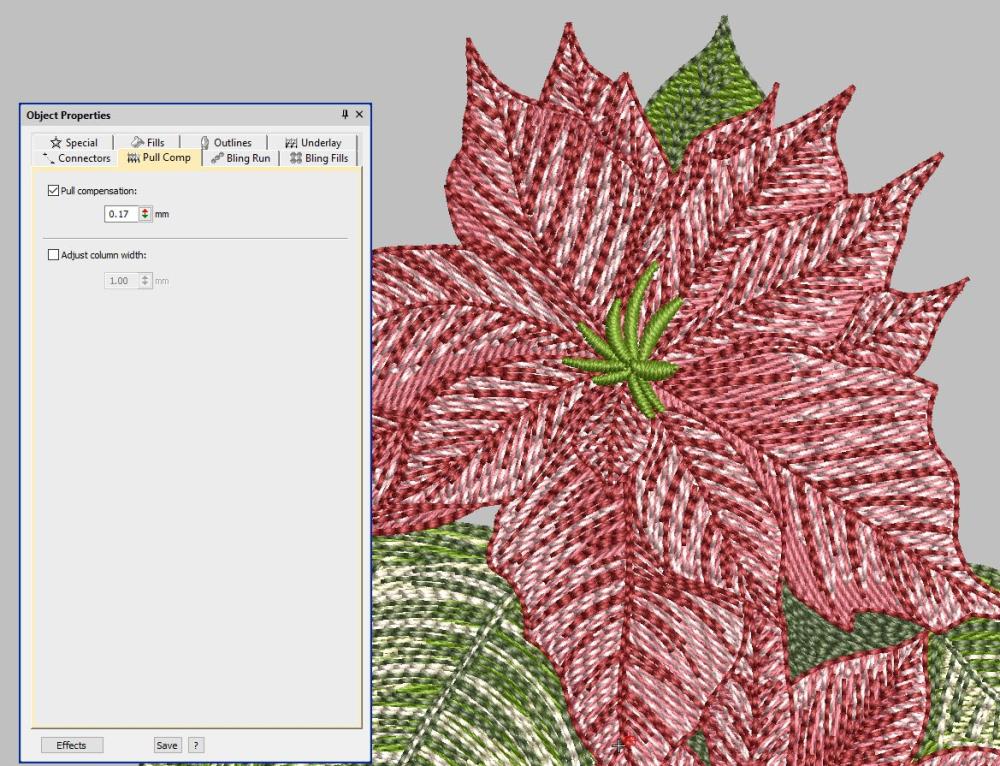Pull Compensation - options for different fabrics
When the needle penetrates the fabric and the top embroidery thread connects and wraps around the bobbin embroidery thread it locks and creates a pulling in effect. Most fabrics require that Pull Compensation be added in order to compensate for this push and pull effect brought about when you stitch an embroidery design into the fabric. When stitches are applied to fabric some degree of pull or push may occur. The stitches can either pull the fabric in on the sides or push the fabric out on the ends, adding a small amount of extra stitches in the direction of the angle of the fill or column. Stitch length (long stitches as satin generate more problems), stitch type, density, underlay, fabric type and even type and amount of stabilizers (tear-away, cut-away, water.. etc.) used are factors that can account for the amount of pull or push you might experience. A very simple description is that pull compensation makes an adjustment to the width of the satin or fill stitch area that in appearance seems to not be wide enough. Compensation for pulling is used in 99% of machine embroidery designs. In this case, we used a multi-layer complex design from our collection Teddy Bears Machine Embroidery Designs.
|
Best compensation value for Wilcom ES 2
drills, cotton - 0.20 T-shirt - 0.35 fleece, jumper - 0.40 lettering - 0.2-0
|
In other words, a gap may be forming between an outline stitch and a fill stitch area which may result in poor registration of the embroidery design. Pull compensation broadens the rows of stitches to adjust for this. You will not always see this problem when digitizing the embroidery design and viewing it on your embroidery software screen (example Tajima Pulse Maestro 13), but when embroidering the design, gaps will appear between fill areas or fill areas and outlines.
Satin or Fill stitches
Tips: All types of stitches create the push-pull effect, but it is most prominent when you are using Satin stitches or fill (tatami or complex fill) stitches. This push-pull effect is more prominent in large areas of your design such as your complex or tatami fill areas. You do not add push or pull compensation to the run stitches that you are using for a border. If your borders do not stay in registration with your fill area, it is best to make adjustments to the fill area of your machine embroidery design.
Pull compensation is only added to two edges of the embroidery design, relative to the angle of the fill (complex fill) area. Visualizing a square object, if the angle of the square is set to either 0 or 180 degrees (for any embroidery software probably any value - Punto Softeamweb -45 degrees), the pull compensation will be added to the horizontal edges of the design; if the angle of the stitching is set to either 90 or -90 degrees, the pull compensation will be added to the vertical edges of the design. Evaluation of your design before the final sew-out is an absolute must. There is a tendency with fill stitches to pull and push the fabric in opposite directions, causing the design to appear distorted. Often, compensation can be made when the embroidery design is digitized (on embroidery software), taking into consideration the fact that there will need to be some pull compensation added to design sections, making adjustments by varying the stitch direction, amount of underlay and the stitch density. An example of when you may need to add pull compensation is when a circle containing fill stitches is outlined with a satin stitch or straight stitch. The two areas may not meet, causing a gap between the outline and the fill stitch. If the circle tends to flatten out on one or two sides, an adjustment can be made during the digitizing of the design. What happens in this instance is that the fabric is being pushed in one direction by the actual stitching. By adding pull compensation to the fill stitch of the circle and/or changing the fill direction this can be corrected. If you are not the digitizer, you may be able to make your own adjustments by using editing software such as Embird Editor, adjusting the pull compensation slightly. You may not find the correct amount of pull compensation to add the first time, so it is critical that test sew-outs of the design be made after every change. Certain types of stitches do not allow for pull compensation. A fill or satin stitch has width to it as part of its design, so pull compensation can be added. Outline stitches such as a straight stitch, motif outline stitch or manual stitch outlines are used to define a shape or outline an embroidery design and do not have width to them, so pull compensation cannot be added to this type of stitch. If you did wish to add pull compensation to an outline, changing the outline to a satin stitch would be one way of overcoming this problem. One disadvantage to changing a straight stitch to a satin stitch is that it increases the final stitch count. If a stitch count is a consideration and the increase is too significant, try adding the pull compensation to the fill shape to meet the outline stitch. The actual stitch length of the fill stitch may also be altered along with the pull compensation and only slightly affect the overall stitch count.
Pull compensation for text embroidery
Tips: Text also needs compensation. Some letters have horizontal columns, while others have vertical columns. When the threads run horizontally, they lie nicely, but the density will push the threads apart and make the letters slightly taller. The pull is sideways and is not very visible to the eye. With vertical columns, however, the density pulls the fabric together and can make a particular letter appear shorter than the others. Good text will not appear even when viewed on a computer screen. Pull compensation will be worked into the text so that the letters will appear the same height when they are sewn onto the garment.
Pull compensation will not solve puckering. If you are having puckering problems, one of the following may be the problem:
Embroidery design may be too dense for the material on which it is being stitched. Reduce the stitch density of your embroidery design or portions of your embroidery design that are causing you problems. One of the keys to successful embroidery is to keep the density as low as possible and still get the look you want. If you think an area of fill needs more thread, many times you will be better off leaving the top thread stitch density alone and increasing the stitch density of the underlay stitches. As a starting guide, set the density for column (satin) stitches at 3.5 mm to 4.0 mm and fill stitches at 4.0 mm to 5.0 mm, adjusting as necessary after doing a test sew-out.
Too many fills at 45 or 90. Change the fill to a direction other than 45 o or 90 o, even by only 5 or less and the machine embroidery design won't pucker so much.
Hooping and stabilizer
The fabric may not be hooped properly and is moving during stitching. Whenever possible, always use the smallest hoop possible for the embroidery design that you are stitching. A small embroidery design in an overly large hoop leaves more room for fabric movement. When hooped, your material should be tight but not overly stretched you should be able to run your little finger (with very slight pressure) in a circle over the hooped material and not push any material. If you are using the sticky paper method of hooping, be sure there are basting stitches around the outer perimeter of the design for embroidery.
The stabilizer may be providing insufficient support for the embroidered design. Whenever possible, a good quality cut-away stabilizer should be used. Cut-away stabilizers not only provide the best support during stitching but also continue to support the embroidery design throughout the life of the garment. Using a cut-away stabilizer such as a light polymesh stabilizer gives you the strength of a cut-away (1 or 2) and the ability to layer (layers) the stabilizer by adding more layers if necessary.
Improper thread tension. Check the tension of both the upper thread and the bobbin thread. An ideal tension is that the reverse of your stitching will show 1/3 top stitch on each of the outer edges and 1/3 bobbin stitch in the center.





There are no reviews to display.